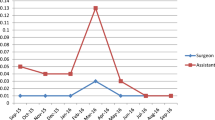Abstract.
Many publications attest to the potential of the sentinel lymph node technique in advancing the clinical management of melanoma and, more recently, breast cancer. Whilst not yet universally regarded as the standard of care, the technique is gaining wide acceptance. Use of a radiolabelled colloidal tracer is central to optimising sensitivity, and this brings with it the need to address radiation safety issues relating to the use of radioactive materials in the operating theatre and pathology laboratory, and the generation of radioactive waste. The radiation dose to the patient should also be determined if the professional is to reassure the patient by placing this in its proper context. For the purpose of this investigation, biodistribution data were obtained from patient studies to quantify the migration of tracer beyond the injection site, thereby permitting a detailed assessment of the internal dosimetry of the tracer and the resulting radiation dose to the patient. Uptake of tracer in the sentinel nodes, reticulo-endothelial system and circulating blood was investigated. The radiation dose to surgical staff was recorded using whole-body monitors and extremity dosimeters worn at the fingers. Clinical waste in the operating theatre was monitored and the radioactive content of significantly contaminated items determined. The radiation dose to pathology staff was estimated from knowledge of the radioactive content of the specimens obtained and a study of work practices. Migration of tracer was found to be minimal, with greater than 95% retention at the injection site. The effective dose resulting to the patient was 2.1×10–2 mSv/MBq, with a mean breast dose of 7.2×10–1 mGy/MBq. A mean whole-body dose of 0.34 µSv was received by surgical staff per procedure, with a mean finger dose of 0.09 mSv (90 µSv). Radiation doses received by pathology staff will be predominantly below measurable levels and are likely to be negligible unless primary specimens from a large number of studies are analysed promptly upon their excision. At operation, surgical swabs can become significantly contaminated and have been found to contain up to 22% of the administered activity, dependent upon the surgical procedure performed. It is concluded that moderate activities of technetium-99m labelled tracer are administered to the patient, and the radiation risk to the patient is consequently low relative to that from many other medical exposures. The radiation doses to staff groups involved in all aspects of the technique are low, and under normal circumstances and levels of workload, routine radiation monitoring will not be required. Standard biohazard precautions prevent direct intake of radioactive contamination. Radioactive waste is created in the operating theatre, and may be generated in the pathology laboratory if specimens are not routinely stored until fully decayed. This will require special handling if the disposal of radioactive material is not permitted.
Similar content being viewed by others
Author information
Authors and Affiliations
Additional information
Received 4 November and in revised form 14 December 1999
Rights and permissions
About this article
Cite this article
Waddington, W., Keshtgar, M., Taylor, I. et al. Radiation safety of the sentinel lymph node technique in breast cancer. Eur J Nucl Med 27, 377–391 (2000). https://doi.org/10.1007/s002590050520
Issue Date:
DOI: https://doi.org/10.1007/s002590050520




